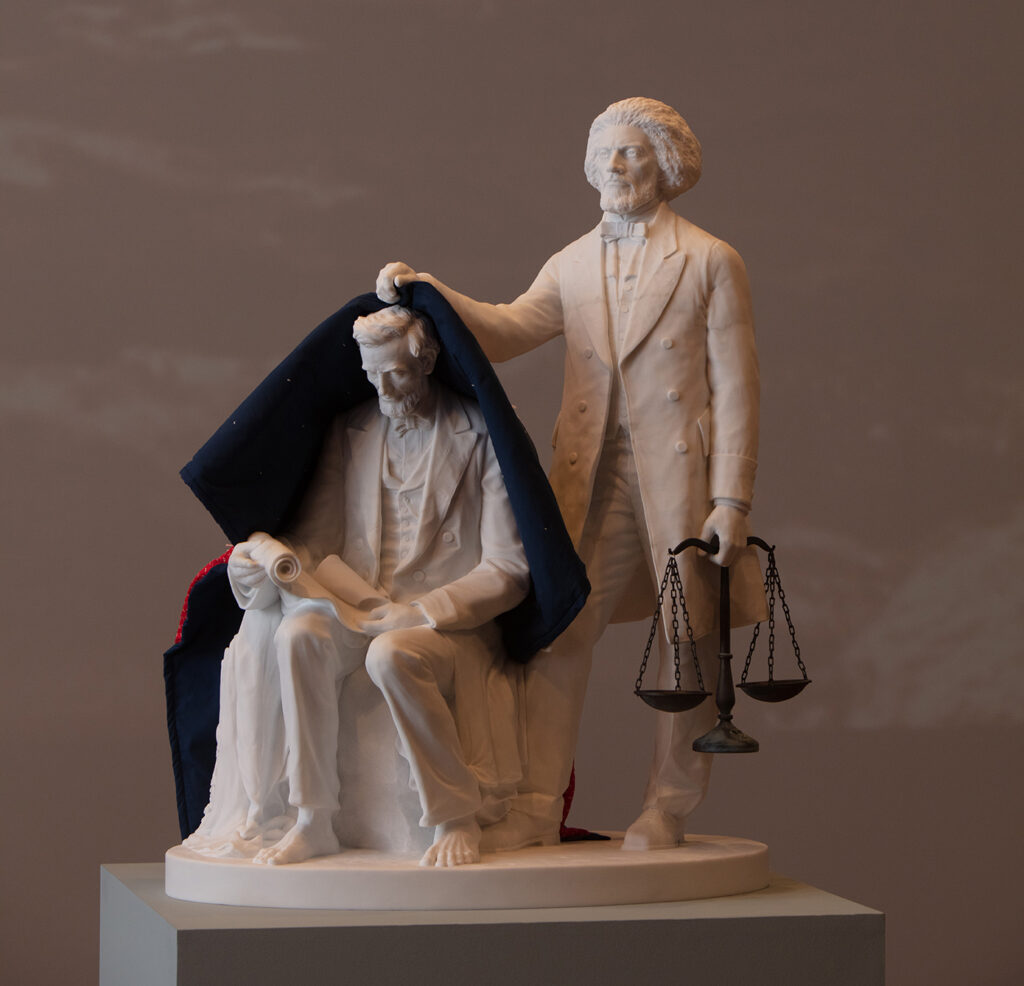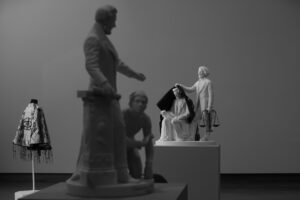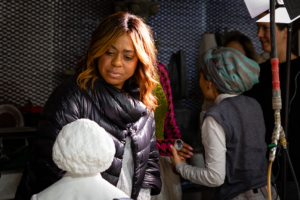MADISON, Wis. – When artist Sanford Biggers visited the Chazen Museum of Art at the University of Wisconsin–Madison in 2019, he had a jarring encounter with Thomas Ball’s Emancipation Group (1873), a four-foot marble sculpture that sat atop a pedestal in the gallery. Although familiar to Biggers, the depiction of an impeccably dressed Abraham Lincoln heroically towering over a partially-clothed freedman incited a visceral reaction that day. His response to that moment instigated the subsequent two years of the re:mancipation project which includes a new sculpture, Lifting the Veil, that strips Lincoln of his saviorhood and turns it over to Frederick Douglass, a freedman, abolitionist, author and public figure who had a complex relationship with the president.

Lifting the Veil by Sanford Biggers
The new sculpture, which mirrors Ball’s work in size and medium, debuted May 4 at the Chazen Museum of Art as part of re:mancipation, a multi-year project that includes a documentary, a national symposium series, supporting research, archival material, educational resources and an exhibition on view at the Chazen through June 25. The title is intentionally lowercase to address the hierarchies that capitalization can reinforce in our culture.
“Lifting the Veil asserts the wisdom, power and foresight of Frederick Douglass, an African American pillar of our history, and gives the Chazen Museum of Art the privilege of recontextualizing a challenging work that reflects our American past and, in many ways, addresses today’s social and racial injustices,” said Amy Gilman, the Chazen Museum of Art’s director. “The murder of George Floyd in 2020 and the subsequent removal of monuments across the country, including Thomas Ball’s Emancipation Memorial in Boston, triggered a heightened sense of urgency for us to address Emancipation Group’s place in our collection and the Museum’s role in confronting contentious works on view.”

Lifting the Veil at right, contrasted with Emancipation Group, center and a Wide Awake Cape at left.
Ball’s marble sculpture in the Chazen’s collection was a study for Emancipation Memorial (1875), the bronze monument erected in Washington, D.C.’s Lincoln Park. At the sculpture’s dedication in 1876, Douglass expressed disappointment in the partial truth it portrayed. In creating an object to mark the end of slavery in the United States, Douglass believed Ball failed to acknowledge enslaved people who protested, escaped and went to other active lengths in the quest for freedom. “The negro here, though rising, is still on his knees and nude,” Douglass said of Ball’s monument. “What I want to see before I die is a monument representing the negro, not couchant on his knees like a four-footed animal, but erect on his feet like a man.”
In Biggers’ Lifting the Veil, Douglass stands above a seated, pensive Lincoln holding an antique red, white and blue quilt in his hand that he has lifted from Lincoln’s eyes. Biggers found inspiration for the name of his new work in Charles Keck’s Lifting the Veil of Ignorance. The 1922 monument on the campus of Tuskegee University depicts Booker T. Washington lifting the veil of ignorance from an enslaved man and is a tribute to Washington’s important work of using education and agriculture to introduce African Americans to a better life.
“In Lifting the Veil, history and dialogue are my primary media. I combined my encounter with Emancipation Group in 2019 with the conversations that have been circulating around monuments to create a new work that hybridizes Charles Keck’s depiction of Booker T. Washington and Thomas Ball’s sculpture,” explained Biggers. “Lifting the Veil serves as an artistic intervention in which we have examined a museum’s collection, acknowledged the complicated histories behind some works and proposed a pedagogical and object-based intervention to illuminate innovative ways of interpreting works on view.”

Camille Friend, Academy Award-nominated hair designer consulted on the fabrication of Lifting the Veil.
Fabrication for Lifting the Veil, which took place at Quarra Stone Company in Madison, Wisconsin, included input from Oscar-nominated hairstylist Camille Friend. As fabricators refined Douglass’ hair, she provided guidance about his hair type based on an array of historic images, ensuring that Biggers’ sculpture accurately reflects Douglass’ texture and curl pattern. “So often, American white men look at Italian sculptures and replicate that style as they depict African Americans. This is apparent in Thomas Ball’s sculpture as well as Chris Keck’s representation of Booker T. Washington,” said Biggers. “Hair is an important part of African and African American culture and one of Frederick Douglass’ most recognizable traits. It was important to me to veer away from neoclassical styles and enlist the counsel of someone who specializes in hair to perfect such an important element of the work.”
The debut of Lifting the Veil marks an important milestone in re:mancipation, a partnership between Biggers, the Chazen Museum of Art at the University of Wisconsin–Madison and the MASK Consortium, as the Chazen continues to consider new ways of display and interpretation. Using objects in the permanent collection to work through complex ideas and collaborating with artists in all media has been one of the institution’s primary approaches to advancing that goal. The re:mancipation project is the most significant realization of this type of work to date. Divided into four thematic sections, the re:mancipationexhibition at the Chazen highlights the collaborative process of the project and encourages visitors to participate in the conversation.
re:mancipation has been supported through a grant from the Mellon Foundation with additional support from the National Education Association, the Brittingham Wisconsin Trust, UW–Madison’s Office of the Chancellor and members of the Milwaukee arts community, including the African American Network, African American Leadership Alliance Milwaukee, America’s Black Holocaust Museum and others.
About the Artists
Sanford Biggers’ work is an interplay of narrative, perspective and history that speaks to current social, political and economic happenings while also examining the contexts that bore them. Biggers (b. 1970) was raised in Los Angeles and currently lives and works in New York City. He is the recipient of numerous honors and awards, including Morehouse College’s Bennie Trailblazer Award (2023), Massachusetts Institute of Technology’s MLK Visiting Scholar and Professor (2022), the 26th Heinz Award for the Arts (2021), Savannah College of Art and Design’s deFINE Art Award (2021), John Simon Guggenheim Fellowship (2020), New York Foundation for the Arts Hall of Fame (2019), and the American Academy in Rome’s Rome Prize in Visual Arts (2017). He has had solo exhibitions at the Speed Art Museum (2022), California African American Museum (2021), the Bronx Museum of the Arts (2020), Contemporary Art Museum St. Louis (2018), the Museum of Contemporary Art Detroit (2016), the Massachusetts Museum of Contemporary Art (2012) and the Brooklyn Museum (2011), among others.
MASK Consortium is a coalition of museums and educational institutions sharing knowledge. Its mission is to develop and promote a more complete understanding of human history and culture through the digital preservation of art and other cultural artifacts via 3D, 360-degree, VR capture. MASK develops curricula and programming for events, conferences and symposia around said works of art. Moreover, they work to create strategic partnerships with museums, universities, state and local government, as well as corporations and individuals who share their goal of fostering connection and expanding knowledge through the preservation and exhibition of art.
About the Chazen Museum of Art
The Chazen Museum of Art makes its home between two lakes on the beautiful campus of the University of Wisconsin–Madison. Within walking distance of the state capitol, it sits squarely in the heart of a vibrant college town. The Chazen’s expansive, two-building site holds the second-largest collection of art in Wisconsin, and at 166,000 square feet, is the largest collecting museum in the Big 10. The collection of approximately 24,000 works of art covers diverse historical periods, cultures and geographic locations, from ancient Greece, Western Europe and the Soviet Empire to Moghul India, 18th-century Japan and modern Africa. For more information: chazen.wisc.edu